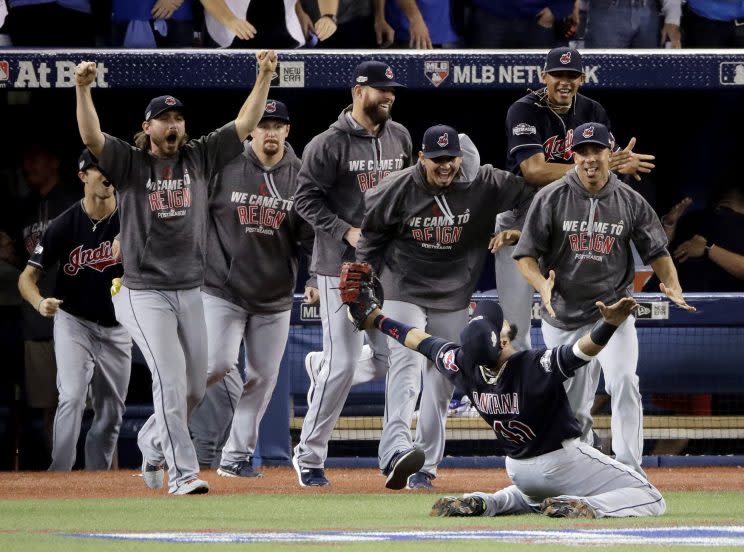This World Series isn't just about the Cubs' title drought
CLEVELAND – The Southwest airplane descended from the clouds and touched down a couple days ahead of the World Series. The night before had ended a little too close to dawn. The flight itself had departed far too near the other side of dawn. So a firm landing served to rouse a decent number of passengers. As the first dull colors of fall streamed past the windows, a scratchy PA system clicked on.
“Welcome,” the woman flight attendant said, “to St. Louis.”
Slowly, the heads of people who’d boarded, many of those people intending to attend the World Series out of duty or plain love, appeared over the backs of the seats in front of them. Their eyes were narrow. It’s still this October, right?
The PA system returned.
“Cleveland,” the voice said. “We’re in Cleveland.”
Pretty sure by then.
Yeah, hardly anybody saw it coming, and now that it’s here it’s still taking some getting used to, and the auto-piloted airplanes maybe are pulling toward St. Louis or somewhere else familiar, and yet by Monday afternoon the two teams taking batting practice here were the Chicago Cubs and Cleveland Indians.

The story, generally, will be whether the Cubs have it in them to make this their year, having pretty well blown the last 107. The Indians look gluttonously decorated by comparison, what with their fancy World Series banner from just 68 years ago. Living people walking the streets of Cleveland have actually seen the Indians win, which maybe is about the lowest possible franchise standard, given World Series championships in my lifetime and rivers caught fire in my lifetime is running neck and neck.
The day before Game 1 showed up gray and (by some standards) cold and windy. So, October. On the same block, within the same hour, the Cleveland Cavaliers will accept their championship rings while the Cleveland Indians set out to earn theirs. Because of all this activity and the preparation involved in suddenly being the center of the sports universe, Panini’s Bar & Grill was working off a short menu a day in advance. Over the bar, a giant television carried a basketball game. It was Game 5 of the NBA Finals, LeBron and Kyrie goin’ off, the Cavs beginning to chip away. Signs of encouragement – “Go Tribe” – blocked out downtown office windows. The stadium, down the block, flooded the neighborhood with music. Television trucks jammed the roads around it.
There is nothing quite like the Cubs’ drought. Nothing. But this place – these folks here in this town – has a story to tell as well, about bygone seasons, about championship famines, about falling behind larger cities with larger revenue streams, about great players going home early again and retiring with a wave of their ring-less hands.
Joe Smith, the Cubs reliever, grew up outside Cincinnati. His grandparents were in Cleveland, however, so he spent time here for holidays and birthday parties. His wife, Allie, is from here. Joe pitched for the Indians for five seasons.
“They want to see a Browns championship,” he said. “That was No. 1. Then the Indians. And what the Cavs did this year was pretty cool for the city. They love their Indians. You perform well and the fans go crazy. This year, it’s like they fed off the Cavs winning that championship. Talking to people here, they feel like that momentum’s contributed to the roll.”
Well, maybe. On June 16, the Cavaliers won Game 6, evening a series the Warriors led, three games to one. The next day, the Indians beat the Chicago White Sox, ending a three-game losing streak. The Indians won again the next day. And the next, that being June 19, the day the Cavaliers won Game 7, ending 52 years of major-sport ignominy in Cleveland. The Indians won again the next day, and the next, and didn’t stop until they’d won 14 consecutive games, from June 17 to July 1, two weeks that lifted them from a half-game in front in the AL Central to seven games up. They won the division by eight games.
In the meantime, the Cavs’ championship parade basically ran a lap around Progressive Field, and Bob DiBiasio, the Indians senior vice president, public affairs, recalled players and staff standing on the concourse watching it pass.
“Man,” he recalled one player musing, “this town can get behind something.”
Some estimated there were 1.3 million people down there, about a million more than live here.
“People who live here, their parents lived here,” DiBiasio said. “Their grandparents lived here. If people do leave, they eventually circle back.”
So, too, does the baseball, perhaps, given enough time, given enough generations. From Bob Feller and Al Rosen to Sandy Alomar Jr. and Manny Ramirez to Francisco Lindor and Corey Kluber, all the way to the end of this October, to a city where, as Indians rookie Tyler Naquin said, “People walk around with a little chip on their shoulder.”
By Tuesday night, the Indians will have survived a 162-game season, two injuries to starting pitchers in September, the Boston Red Sox, Toronto Blue Jays, a drone accident, tooth loss and a celebration mishap in October, and seven decades of baseball that ran from very bad to very good but never ended the way they wanted it to.
Sometimes you have to let it all carry you along, see where it leads. Sometimes you’ll get there and may be a little surprised to learn it’s Cleveland, and that it was supposed to be the whole time.


